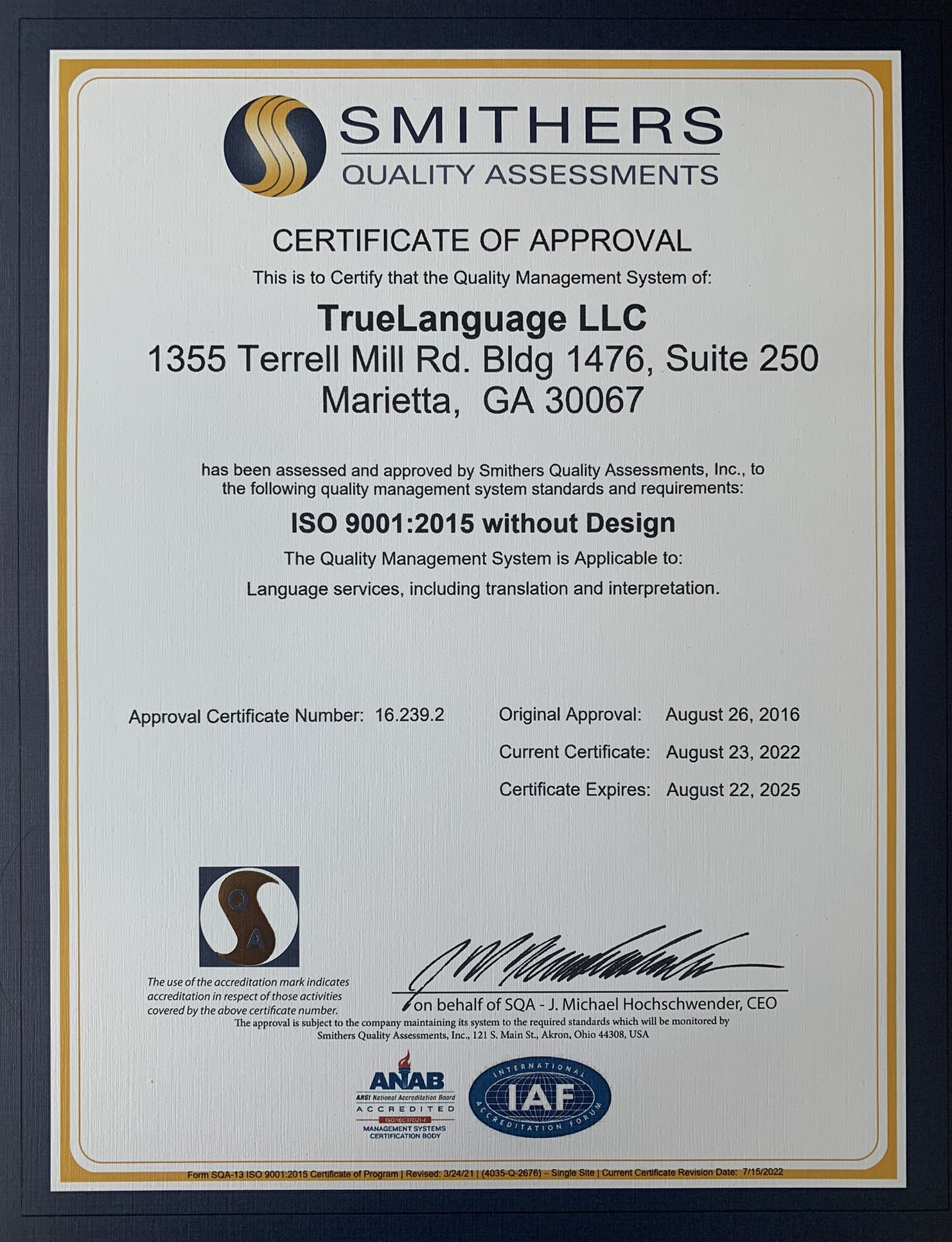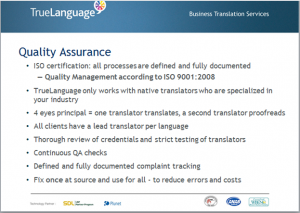This content has been archived. It may no longer be relevant
Not every language and translation service provider is ISO-certified nor are they required to have documented processes for Quality Management in place. When doing business with these translation service providers, you rely on their understanding of and willingness to ensure quality.
TrueLanguage is proud to announce we have just passed the 2022 ISO audit and re-certificaton without any discrepancies.
As an ISO-certified business translation services company, TrueLanguage provides clients with the following process steps that are detailed in a Quality Manual:
What is ISO Certification?
WikiNorm defines ISO certification as: “The abbreviation ’ISO’ stands for International Organization for Standardization. ISO is a series of international standards introduced in 1987 that define and structure a company’s management systems. These standards apply equally to all industries and require companies seeking certification to define how their systems meet the standards’ rigorous requirements. Meeting the standards assures customers that all vendor company activities – design, manufacturing, production, purchasing, quality control, packaging, handling, storage, shipping, and customer service – are appropriately managed and controlled.”
Many industries such as Automotive and Manufacturing require any supplier to be ISO-certified because they are ISO-certified.
We use only native translators with experience in your industry
Our translations are done by native speakers only. This means, no matter how many languages one does speak, he or she would translate out of the foreign language into their native language. Our translators also are subject-matter experts. For example, if you are a manufacturer of high-tech machinery, the translator would most likely have an engineering background and familiarity with your industry. Or if your industry is in life science, the translator may have an educational degree in chemistry or a medical background. Our network of over 1500 tested translators enables us to choose the right translator for each and every project. This is just one of several best practices we have in place.
4 eyes principal
Also known as the translation team. One translator translates the content in his native language preferably in the respective country while another native speaking translator (preferably located in the U.S.) will review the content. This helps to assure we have the culture “bridged” and the best understanding in the original and foreign markets.
Lead translators
Lead translators are appointed to any larger translation project. This translator will read and review all material for consistency, terminology, and overall accuracy. The lead translator works very closely with the project manager. He is usually the first translator the project manager will employ and is often involved in setting up the translation team.
Employing a translator
Although we have an established database with over 1500 tested, reviewed and approved translators, we occasionally employ new translators. The reasons for hiring new translations can range from branching out into new industries to the need for subject-matter experts in new markets.
There is an established process we follow to employ new translators. In order to create a profile for a new translator, we need to know:
– Their expertise and experience
– Languages (source languages and native language)
– Reference materials
– Referrals
– Availability
We also test each applicant and are very selective to ensure we choose the best possible translators for our clients.
Continuous QA checks
Stringent Quality Assurance (QA) processes are paramount to delivering high-quality. One way to ensure this is to continuously revisit our processes and double-check with our translators. At times, we initiate test projects for this purpose and have these evaluated by trusted resources. We check closely to see if the translator applies the right terminology, translates in a timely manner and if the quality matches his or her profile. We also appreciate the feedback we receive from our clients on their translations.
Defined and fully-documented complaint tracking
Part of our Quality Manual and Quality Assurance process is to keep track of every complaint we receive. While we are proud to say that we do not receive complaints from clients often, when it does happen, we want to know so we can immediately address and rectify the situation. We view these experiences as an opportunity to learn and to prevent the same mistake from happening twice.
Fix source to reduce error and costs
Any source file we receive for translation will be analyzed for word count and possible matches. We also take a close look at the formatting. Any formatting issues are addressed by the client because any formatting issue in the source file will end up in the target file. And, if a translation involves 20 languages, this can significantly increase costs and jeopardize timelines.




This blog totally clear out about the ISO which is really important for any service so thanks for sharing this blogging section.http://www.affordableinterpreters.com/
your post clear some points and you discuss this very well. thanks for the post.
http://www.ektranslations.co.uk
AHJ is looking for partner websites in the medicine genre. AmericanHealthJournal is a medicine site which owns over 3000 of high quality medical videos. We are looking for partners who may be interested in writing guest articles to our brand. . Get in touch with us at our contact form on our site.
Thank you – we appreciate your comments and love to hear from you. If you have questions, please reach out to me at doris@truelanguage.com